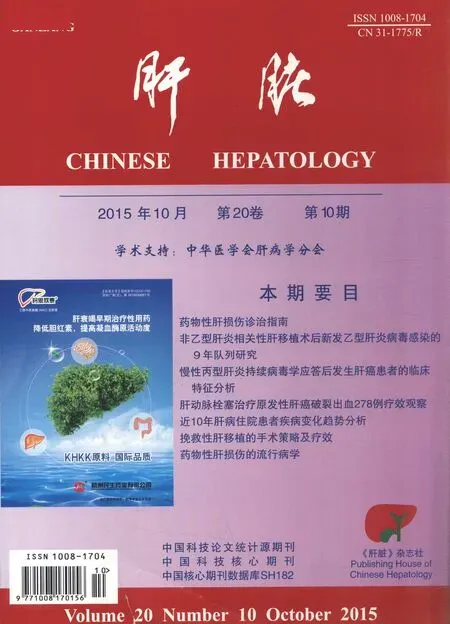挽救性肝移植的手术策略及疗效
2015-03-21刘源万平夏强
刘源 万平 夏强
·热点论坛·
挽救性肝移植的手术策略及疗效
刘源 万平夏强
长期以来,肝移植都被认为是治疗早期肝细胞癌的理想方案。通过移植,不仅能彻底去除原发肿瘤,也解决了潜在的肝硬化[1]。由于目前肝脏供体短缺,相当一部分患者在等待肝源期间因出现肿瘤进展或肝功能恶化而丧失了移植机会。因此,2000年Majno等人提出了挽救性肝移植(Salvage Liver Transplantation,SLT)的概念,即对肝功能处于代偿期的肝癌患者,通过部分肝切的方式切除肿瘤病灶,通过术后密切随访,当患者出现肝癌复发或者肝功能恶化时再行肝移植术[2-4]。与在发现肝癌后直接行肝移植治疗(Primary Liver Transplantation,PLT)相比,接受挽救性肝移植的病人可及时通过外科手术祛除病灶,从而一定程度上降低了患者对于供体器官的依赖,推迟了免疫抑制剂的使用,患者的生活质量得以提高[5-7]。随着肝脏外科手术技术的发展,术前肝功能和肿瘤情况评估水平的提高以及术后随访的完善,挽救性肝移植的手术方案逐渐成熟,患者长期预后也不断得到改善,现就近年来挽救性肝移植的最新发展综述如下。
一、挽救性肝移植的手术标准及预后
米兰标准是国际广泛应用的挽救性肝移植手术入选标准,当肝切后肝癌复发但仍符合米兰标准或出现肝功能衰竭时,年龄小于65岁的患者可再行肝移植术。按照该标准进行筛选,挽救性肝移植患者的长期生存率和无病生存时间与直接行肝移植者相比,总体上无明显差异,在Guerrini的研究中两者的5年生存率以及5年无病生存率相似(49.2%vs 65.4%,80.6% vs 89.7%),并且远高于超过米兰标准的患者[8-13]。但是,米兰标准的严格限定也使得很大一部分患者丧失了进一步治疗的机会。随着各种新的移植标准,比如UCSF标准,杭州标准[14,15]等的提出,不同研究中心的几项回顾性研究都发现,即使将手术标准扩展到UCSF标准或杭州标准,挽救性肝移植和直接肝移植患者的5年生存率也没有表现出统计学差异(61% vs72%,61.1%vs60.1%)[16,17],但是通过上述扩展,可以将入选患者数量提高达40%左右。在我国,挽救性肝移植的治疗效果亦得到肯定。一项全国范围内的回顾性研究显示,挽救性肝移植和直接肝移植患者的5年生存率和5年无病生存率相近(45.8%vs48.8%,37.8%vs43.5%)[18]。而对于初发肿瘤已超过上述筛选标准的患者,Liu等人发现,通过介入手术方式将肿瘤减灭到米兰标准内再行挽救性肝移植术,患者的长期生存率并不低于肝切前即符合米兰标准者[19],但这一结论尚未被其他研究中心接受。因此,按照米兰标准对入选患者进行筛选可以保证患者的长期存活,在准确的临床评估后,将患者入选范围扩大到UCSF标准或杭州标准可以在保证长期生存率的前提下挽救更多患者的生命。
因为挽救性肝移植的患者在移植手术前已行肝切术,腹腔内易出现粘连和解剖结构的改变,这不仅增加了移植手术的难度,移植后感染等术后并发症也更易发生。早期的回顾性研究也多表明,挽救性肝移植的患者在手术时间、术中出血量、住院时间和围手术期死亡率等方面都高于直接肝移植患者[20-22]。但是,随着经验的丰富,外科手术技术的提高和术后护理的完善,越来越多的研究表明挽救性肝移植在手术时间、术中出血量、住院时间等方面都与直接肝移植患者相近,术后并发症和围手术期死亡率也基本持平[11-13]。同时,随着微创外科的发展,肝切造成的腹腔内粘连等问题显著减少,患者术后恢复期得以缩短,术后并发症的发生率也明显降低[23]。通过术前详细了解既往手术的方式和重要的组织解剖异常,术中仔细进行解剖学分离并控制出血,挽救性肝移植的术后并发症也可以控制在和直接肝移植相同的水平。
二、肿瘤特性及其对SLT手术方案的影响
肝癌患者肝切后需再行挽救性肝移植的最主要原因是出现了肝癌肿瘤的复发,而肝切后肿瘤的早期复发和复发时已经超过移植标准是影响预后的重要因素,所以预先判断肿瘤复发的部位和时间,能够更加准确的指导肝切前患者的筛选和治疗方案的调整,实现疗效的最优化。肝癌的复发来源于两种途径:手术前已有的播散和原有肝脏中未被完全清除的微型肿瘤灶。大多数的复发源于前者,但这种患者因易合并肝外复发而不适合进行挽救性肝移植;相对的,由于肝内未清除的原发癌灶导致的复发,癌灶更多的是单一病灶,挽救性肝移植对这些患者疗效会更好[24-26]。借助术前临床资料和术后病理报告可以对肝切后肿瘤的行为进行预测。在米兰标准下,被切除组织中发现小血管侵袭,肿瘤分化度低,癌灶过于分散,存在肝癌卫星灶或额外的肝内异型结节等均提示肝癌可能存在未知的转移,即这类患者属于术后早期肝癌复发的高危组,其早期复发率可达86%,复发后易产生肝外转移从而超过移植标准。对于此类患者,应在肝切手术后尽快列入肝移植名单并尽早进行移植手术以防止肿瘤复发时恶性度过高丧失移植的机会。而没有上述表现的患者属于肝癌复发的低危组,其复发率只有20%左右,这些患者术后可进行常规随访,当发现肿瘤复发时,大部分患者仍然符合挽救性肝移植的标准[8,9,27-29]。这种借助临床资料预测肿瘤行为的方式可以将肝切后的患者进行分组并实行个体化治疗方案。不过高危组患者是否能够真的得益于尽早执行的挽救性移植在近期受到质疑,Margarit等人的研究发现几乎所有肝外复发的患者都存在微血管侵袭和卫星灶,而这类患者挽救性移植的预后不佳,建议应在复发后以辅助治疗或介入治疗为主[11]。此外,手术方式也被认为是复发的影响因素之一,解剖型肝切因能够降低侧支转移、降低复发率,而被认为优于非解剖性肝切[30]。
目前依据临床影像和病理分析评估肿瘤临床特点,进而预测肝癌的转移仍存在一定的局限性[31],Schwartz等人提出可利用分子生物学的方法对肿瘤的行为进行预测,通过分析肿瘤病灶中几个已知抑癌基因和原癌基因位点附近微卫星灶的等位不平衡(Allelic imbalance of microsatellites)情况来估测肿瘤的复发率,其敏感性可达83%,特异性91%,其中位于原癌基因1-myc附近的微卫星灶MYCL 5NT,不仅与肝癌复发的联系最紧密,而且可以影响复发后肿瘤的行为[27]。随着目前对肿瘤发病分子机制研究的深入,这种通过基因组学的方法来预测肿瘤复发特征的研究今后将会为临床分析提供更多可靠的检测方案,继而为挽救性肝移植入选标准提供更多的参考依据,通过完善入选标准,能够更加准确的预判患者的预后,实现供体器官的合理分配。
三、活体肝移植在SLT中的应用
虽然挽救性肝移植能够在一定程度上缓解肝癌患者对于肝源的急性需求,但仍有相当一部分肝切患者因为缺乏供体器官丧失了最佳的移植机会。因此将活体肝移植(Living donor liver transplantation,LDLT)运用于挽救性肝移植中可极大的缩短患者的等待时间。挽救性LDLT同尸体肝移植(Deceased donor liver transplantation,DDLT)相比,患者的长期生存率没有显著差异,同直接LDLT患者的长期生存率也无区别,并且米兰标准、UCSF标准等同样适用于挽救性LDLT中的病人筛选,但其肿瘤术后的复发率可能会有所增加,曾有研究认为从活体供体劈离的部分肝脏在移植后生长过程中会激活肿瘤相关基因通路,从而促进了残存肿瘤的生长[32],因此对于LDLT在肝癌复发病人中的应用还有待更多的研究。目前LDLT在临床应用中主要面临着伦理学、手术难度高和术后并发症复杂等挑战。随着手术技术的进步,目前在有经验的移植中心,移植供者基本实现零死亡[33],虽然术后并发症的发生率可达24%,但通过严密的术后观察和治疗,术后并发症对供者生活质量的不利影响可被基本消除,而供者术后可能出现的精神心理改变或许成为目前面临的新问题[34]。
为了克服LDLT在临床上面临的困难,新的辅助技术的应用令人瞩目,如利用CT三维重建、3D打印技术模拟移植物血管情况,并辅助对移植物的容量评估[35],腹腔镜微创技术切取移植物,双移植物活体肝移植术(Dual graft LDLT)[36],ABO跨血型移植和门脉栓塞患者移植的研究[37,38]等都为LDLT在挽救性肝移植中的应用拓宽了思路,另一方面因为在不少国家活体移植器官被认为不属于公共资源,这使得不少移植中心能够扩宽LDLT的手术标准,研究在米兰标准、UCSF标准以外的挽救性LDLT的临床预后,扩大LDLT的受益患者群体[39]。上述进展亦是对挽救性肝移植领域研究的补充,并极大的推进了LDLT在临床中的应用。
四、总结与展望
肝移植是早期肝癌合并Child-Pugh B级以上或A级合并门脉高压患者的首选治疗方法。但对于早期单个肝癌病灶、肝功能正常、不合并门脉高压患者的最佳治疗方案却有待讨论。虽然欧洲专家建议首选肝移植,但缺乏供体等问题严重影响了肝癌患者的移植率。挽救性肝移植这一概念的提出给肝癌的临床治疗提供了新的思路。通过一期行肝切的方式使得一部分患者能在摆脱免疫抑制剂的情况下实现长期生存,而根据肿瘤病理学表现,并辅助以基因组学分析技术,临床医生有望在未来实现肝切后病人个体化的治疗。这样不仅可以显著改善患者的总体预后,也同时实现了供体器官的最优化分配。活体挽救性肝移植目前是肝移植领域的关注热点,其发展可以极大的缓解目前供体器官紧张的局面,但较高的手术难度和复杂的围手术期管理限制了其在临床的应用。临床技术的创新和多学科联合研究成为了突破上述阻碍的重要推动力,并同时促进了其他疾病外科治疗的发展。而对于活体挽救性肝移植术后肿瘤复发行为的多中心研究将很大程度上决定活体挽救性肝移植在未来的应用,如何在尽可能减少肿瘤复发的情况下挽救更多肝癌患者的生命,是临床医生不断追求和奋斗的目标。
1Belghiti J,Cortes A,Abdalla EK,et al.Resection prior to liver transplantation for hepatocellular carcinoma.Ann Surg,2003,238:885-892;discussion 892-883.
2Fuks D,Dokmak S,Paradis V,et al.Benefit of initial resection of hepatocellular carcinoma followed by transplantation in case of recurrence:an intention-to-treat analysis.Hepatology,2012,55:132-140.
3Poon RT,Fan ST,Lo CM,et al.Improving survival results after resection of hepatocellular carcinoma:a prospective study of 377 patients over 10 years.Ann Surg,2001,234:63-70.
4Moon JI,Kwon CH,Joh JW,et al.Primary versus salvage living donor liver Transplantation for patients with Hepatocellular carcinoma:impact of microvascular invasion on survival.Transplant Proc,2012,44:487-493.
5Adam R,Azoulay D.Is primary resection and salvage transplantation for hepatocellular carcinoma a reasonable strategy Ann Surg,2005,241:671-672.
6Hu Z,Wang W,Li Z,et al.Recipient outcomes of salvage liver transplantation versus primary liver transplantation:a systematic review and meta-analysis.Liver Transpl,2012,18:1316-1323.
7Poon RT,Fan ST.Resection prior to liver transplantation for hepatocellular carcinoma:a strategy of optimizing the role of resection and transplantation in cirrhotic patients with preserved liver function.Liver Transpl,2004,10:813-815.
8Sala M,Fuster J,Llovet JM,et al.High pathological risk of recurrence after surgical resection for hepatocellular carcinoma:an indication for salvage liver transplantation.Liver Transpl,2004,10:1294-1300.
9Llovet JM,Fuster J,Bruix J.Intention-to-treat analysis of surgical treatment for early Hepatocellular carcinoma:resection versus transplantation.Hepatology,1999,30:1434-1440.
10Mazzaferro V,Regalia E,Doci R,et al.Liver transplantation forthe treatment of small hepatocellular carcinomas in patients with cirrhosis.N Engl J Med,1996,334:693-699.
11Margarit C,Lluis Escartin A Fau-Castells,Victor Castells L Fau-Vargas,et al.Resection for hepatocellular carcinoma is a good option in Child-Turcotte-Pugh class A patients with cirrhosis who are eligible for liver transplantation.(1527-6465(Print)).
12Guerrini GP,Gerunda GE,Montalti R,et al.Results of salvage liver transplantation.Liver Int,2014,34:e96-e104.
13张建军,李齐根,张明等.肝移植术治疗复发性肝细胞癌.肝胆外科杂志,2007,6:427-430.
14Yao FY,Ferrell NM,Fau-Bass L,Bass Nm Fau-Watson JJ,et al.Liver transplantation for hepatocellular carcinoma:expansion of the tumor size limits does not adversely impact survival.(0270-9139(Print)).
15Zheng SS,Xu X,Wu,et al.Liver transplantation for hepatocellular carcinoma:Hangzhou experiences.Transplantation,2008,85:1726-1732.
16Kim BW,Park YK,Kim YB,et al.Salvage liver transplantation for recurrent Hepatocellular carcinoma After liver Resection:feasibility of the Milan criteria and operative risk.Transplant Proc,2008,40:3558-3561.
17Hu Z,Zhou J,Li Z,et al.Salvage liver transplantation for recurrent Hepatocellular carcinoma After liver Resection:retrospective study of the Milan and Hangzhou criteria.PLoS One,2014,9:e87222.
18Liu F,Wei Y,Wang W,et al.Salvage liver transplantation for recurrent hepatocellular carcinoma within UCSF criteria after liver resection.PLOS One,2012,7:e48932.
19张彤,傅斌生,孟炜,等.补救性肝移植和Ⅰ期肝移植治疗原发性肝癌的对比观察.中华肿瘤防治杂志,2010:1858-1861.
20Vennarecci G,Ettorre GM,Antonini M,et al.First-line liver resection and salvage liver Transplantation Are increasing therapeutic strategies for patients with hepatocellular carcinoma and child a cirrhosis.Transplant Proc,2007,39:1857-1860.
21Adam R,Azoulay D,Castaing D,et al.Liver resection as a bridge to transplantation for hepatocellular carcinoma on cirrhosis:a reasonable strategy.Ann Surg,2003,238:508-518.
22王征,樊嘉,周俭等.挽救性肝移植治疗肝癌切除术后复发的价值研究.中国普外基础与临床杂志,2011:362-365.
23Laurent A,Tayar C,Andreoletti M,et al.Laparoscopic liver resection facilitates salvage liver transplantation for hepatocellular carcinoma.J Hepatobiliary Pancreat Surg,2009,16:310-314.
24Poon RT,Fan ST,Ng IO,et al.Different risk factors and prognosis for early and late intrahepatic recurrence after resection of hepatocellular carcinoma.Cancer,2000,89:500-507.
25Arii S,Monden K,Niwano M,et al.Results of surgical treatment for recurrent hepatocellular carcinoma;comparison of outcome among patients with multicentric carcinogenesis,intrahepatic metastasis,and extrahepatic recurrence.J Hepatobiliary Pancreat Surg,1998,5:86-92.
26Imamura H,Matsuyama Y,Tanaka E,et al.Risk factors contributing to early and late phase intrahepatic recurrence of hepatocellular carcinoma after hepatectomy.J Hepatol,2003,38:200-207.
27Schwartz M,Dvorchik I,Roayaie S,et al.Liver transplantation for hepatocellular carcinoma:extension of indications based on molecular markers.J Hepatol,2008,49:581-588.
28Llovet JM,J Bruix J Fau-Fuster,A.Fuster J Fau-Castells,et al.Liver transplantation for small hepatocellular carcinoma:the tumor-node-metastasis classification does Not Have prognostic power.(0270-9139(Print)).
29Plessier A,Yann Codes L Fau-Consigny,Daniele Consigny Y Fau-Sommacale,et al.Underestimation of the influence of satellite nodules as a risk factor for post-transplantation recurrence in patients with small hepatocellular carcinoma.(1527-6465 (Print)).
30Zhou Y,Xu D,Wu L,et al.Meta-analysis of anatomic resection versus Nonanatomic Resection for hepatocellular carcinoma.Langenbecks Arch Surg,2011,396:1109-1117.
31Ravaioli M,Matteo Ercolani G Fau-Cescon,Gaetano Cescon M Fau-Vetrone,et al.Liver transplantation for hepatocellular carcinoma:further considerations on selection criteria.(1527-6465 (Print)).
32Hwang S,Jae-Won Lee Sg Fau-Joh,Kyung-Suk Joh Jw Fau-Suh,et AL. iver Transplantation for adult patients with hepatocellular carcinoma in Korea:comparison between cadaveric donor And living donor liver Transplantations.(1527-6465 (Print)).
33Intaraprasong P,Sobhonslidsuk A,Tongprasert S.Donor outcomes after living donor liver transplantation(LDLT).J Med assoc Thai,2010,93:1340-1343.
34Yang X,Gong J,Gong J.The value of living donor liver transplantation.Ann Transplant,2012,17:120-124.
35Ikegami T,Maehara Y.Transplantation:3D printing of the liver in living donor liver transplantation.Nat Rev Gastroenterol Hepatol,2013,10:697-698.
36Lee SG,Hwang KM,Fau-Park S,K.H.Park Km Fau-Kim,et al.Seventeen adult-to-adult living donor liver transplantations using dual grafts.(0041-1345(Print)).
37Xiao GQ,Song JL,Shen S,et al.Living donor liver transplantation does not increase tumor recurrence of hepatocellular carcinoma compared to deceased donor Transplantation.World J Gastroenterol,2014,20:10953-10959.
38Moon DB,Lee SG,Ahn CS,et al.Section 6.Management of extensive nontumorous portal vein thrombosis in adult living donor liver transplantation.Transplantation,2014,97 Suppl 8:S23-30.
39鲁皓,张峰.活体肝移植研究进展.实用器官移植电子杂志,2013:297-305.
2015-04-23)
(本文编辑:冯珉)
200127 上海 上海交通大学医学院附属仁济医院肝脏外科
夏强,Email:xiaqiang@medmail.com.cn
